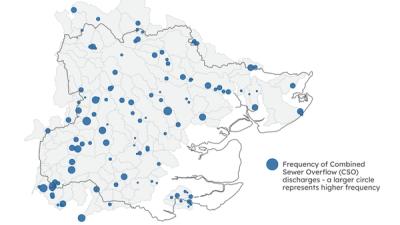Combined Sewer Overflows
Intermittent sewage discharge, also known as storm overflows or combined sewer overflows (CSOs) are a result of old Victorian sewer infrastructure. Overflows work as a way for the pressures of excess water to escape the system. They discharge excess sewage and rainwater to waterbodies which reduces the risk of properties flooding and prevents sewage backing up during heavy rainfall.
A growing population, an increase in impermeable concrete surfaces and more frequent heavy storms because of climate change, means that storm overflows are discharging more frequently than when sewers were first designed and installed.
To reduce the risk of storm overflows we must reduce the volume of rainwater and sewage entering the sewage network, so that even in times of heavy rainfall, the capacity of the network is not exceeded. There is also a need to ensure that households only ever flush the 3 P’s (Pee, Poop and Paper!) down toilets to prevent blockages and avoid overflows containing other physical items.
The ‘Is my river fit to play in’ map by The River Trust shows where the sewerage network discharges treated sewage and overflows of untreated sewage and storm water into rivers in England & Wales in 2022. One community group in Essex, the Manningtree Mermaids, are running a campaign called Safer Water In Manningtree (S.W.I.M). The campaign is for bathing designations in the area, which would provide a legal mechanism to hold polluters to account (BBC News, February 2023).

High levels of sewage discharges cause two main types of harm: harm to public health and to the environment. Discharges from storm overflows contain raw sewage, which can contain high levels of harmful viruses and bacteria. This can pose health risks to people who use water for recreation. They also lead to ecological harm due to their impact on water chemistry. Discharges of raw sewage can have organic pollutants, microplastics, pharmaceuticals, nutrients, and heavy metals, as well as visible litter that has been incorrectly flushed down toilets.
There are around 146 storm overflow points in Essex (The Rivers Trust Sewage Map). They discharge at different rates depending on local conditions including rainfall, and the type of sewerage system. In 2021, 88% of storm overflows discharged at least once, with 15% discharging more than 50 times, including in some cases upstream of our high priority nature sites and Sites of Special Scientific Interest (SSSI).
When we look at the Environment Agency data for reasons for not achieving good status, the water industry is responsible for 25% of the known problems in Essex, although these are a combined problem of storm overflows and the continuous release of nutrients within treated effluent discharges from sewage treatment works (meeting permitted conditions).
In the DEFRA Storm Overflows Discharge Reduction Plan, new targets will force upgrades to our sewer system and ensure increased interception of rainfall runoff into sewers by using green infrastructure.